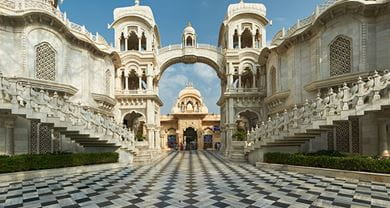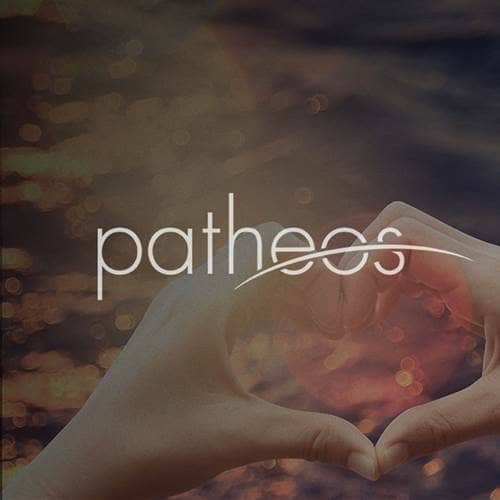- Trending:
- Pope Leo Xiv
- |
- Israel
- |
- Trump
- |
- Social Justice
- |
- Peace
- |
- Love

RELIGION LIBRARY
ISKCON (Hare Krishna)
Ultimate Reality and Divine Beings
By its own understanding as well as that of scholars, ISKCON is a highly monotheistic tradition, but one that, like other sects of Hinduism, accepts the notion of God taking multiple forms. Behind these many forms that God might take -- avatars, to use the technical term -- the Hare Krishna movement identifies Krishna as the supreme being. In the parlance of the movement, Krishna is the Supreme Personality of Godhead, the being who has ordained the cyclical creation, maintenance, and destruction of the universe, and who periodically takes physical form in order to engage with creation. Yet behind those manifestations, Krishna exists as a transcendent supreme person. As such, Krishna possesses a personality, likes and dislikes, and other qualities normally associated with people. As a transcendent being, Krishna lacks physical or personal limitations, but instead possesses infinite levels of positive qualities such as love, devotion, and wisdom. ISKCON devotees often describe Krishna as the Supremely Attractive One.
Unlike many of the other Hindu transplant movements that have spread to the West, such as the Vedanta Society or Transcendental Meditation, the Hare Krishna movement adamantly rejects the impersonalist schools of Hindu philosophy. Such philosophies, generally rooted in the ancient Hindu texts of the Upanishads, identify the divine with a formless essence, or Brahman, that underlies all existence. In distinction, ISKCON follows the approach of understanding Brahman as an emanation originating from Krishna, comparing it to the light emanating from the sun.
Although Supreme and singular, devotees believe that Krishna assumes numerous forms and natures. Chief among these are the deific personhoods that Krishna uses in order to create the cosmos; the foremost of such is Maha-Vishnu ("Great Vishnu"). In his form as Maha-Vishnu, Krishna creates the material universe in all of its physical forms. This belief separates ISKCON from all other forms of Hinduism outside the Gaudiya Vaishnava school, since broader Hinduism considers Vishnu the supreme person from which Krishna descends.
Krishna also takes more earthly forms, or avatars, in order to interact with creation. Often, Krishna does so in order to the save the world from its ills, to offer teachings, or to give human beings a chance to demonstrate devotion. The most important of these avatars is that of Krishna himself. That is, devotees believe that during the events described in the Bhagavata Purana and Mahabharata, the Supreme Personality of Godhead took earthly incarnation in his own form with his own personality, nature, and name. During this moment, the avatar of God equated God himself. For this reason, ISKCON devotees look to the stories of Krishna's earthly pastimes and activities as particularly noteworthy.
This is not to say that the Hare Krishna movement does not value the other avatar forms of Vishnu. ISKCON follows the general contours of the broader Hindu tradition in accepting the ten central avatars of Vishnu: Matsya (the fish), Kurma (the tortoise), Varaha (the boar), Narasimha (the lion-man), Vamaha (the dwarf), Parashumara (Rama with an axe), Rama, Krishna, Buddha, and Kalki (the avatar to come). In addition to these ten, ISKCON accepts numerous additional avatars upheld by other Vaishnava traditions, such as Balarama, Nara, and Narayana.
One avatar belief distinguishes ISKCON from all other Vaishnava lineages, save that of Gaudiya Vaishnavism, the movement's theological origin. The Hare Krishna movement recognizes the 16th-century reformer Chaitanya (1486-1533) as not only a saint, but a divine avatar. In fact, the movement recognizes Chaitanya as Krishna himself in physical form, taking appearance so as to demonstrate how to devote oneself to God. Since Chaitanya also founded the religious lineage from which ISKCON derived, this belief places Krishna himself at the origin point of the religious movement.
ISKCON devotees also believe that Krishna exists as a binary pairing, that of Krishna and Radha. The Bhagavata Purana and other devotional works portray Radha as the most radiant of the gopis, the cowherd girls who frolicked with Krishna, and his most intimate of companions. On a more cosmic sense, Hare Krishna devotees believe that Radha is both identical and different from Krishna. They are the same since the two together form the singular Krishna, the one God. Yet they are also different, since the two represent the male and female halves of the divine, incomplete without each other. Some ISKCON materials explain this distinction as that between matter and energy. In this reading, Radha represents the energy (shakti) of Krishna, which emanates throughout the universe. For these reasons, Hare Krishna practitioners often worship Krishna in his form as both Krishna and Radha.
Though all devotees place Krishna at the absolute center of their theology, the movement accepts the existence of numerous divine beings called demigods. ISKCON understands these superhuman beings as created by Krishna in order to serve him, and therefore they function as divine paragons of devotion. Generally, ISKCON equates these demigods with the other deities of Hinduism, such as Shiva, Ganesha, and Lakshmi. In its subordination of such deities to the role of devotees of Krishna, ISKCON differentiates from most other forms of the Hindu tradition.
ISKCON devotees recognizes other monotheists as fellow worshippers of God, but believe that those outside their own lineage lack access to God in his Supreme Personhood of Krishna. As such, other understandings of the divine, e.g., Allah or Jehovah, lack the same transcendental quality as Krishna. Still, the Hare Krishna movement considers other forms of monotheistic religious devotion valid forms of spirituality, albeit lacking the advantages of knowledge of God in his most intimate form.
Study Questions:
1. How do avatars allow ISKCON to remain monotheistic?
2. How does Maha-Vishnu separate ISKCON from other forms of Hinduism?
3. Who is Radha? What is her relationship to Krishna within ISKCON?
4. How do ISKCON followers perceive individuals of other religious traditions?










